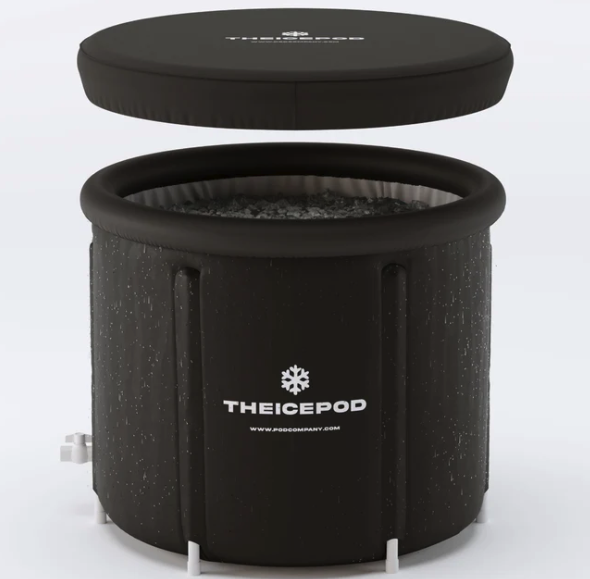Are Saunas and Ice Baths Good for Recovery?
Written by The Boostcamp Editors
Are these methods of recovery scientifically accurate, or just fads?
When it comes to recovery after your weight training, even your cardio training, or whatever other sport you participate in, there are so many methods to try and make the process smoother and more effective. It is no doubt that recovery is largely important for your progression, whether you are a bodybuilder or a strength athlete such as a powerlifter or Olympic weightlifter, as this is where you truly grow and make gains.
Recovery methods such as proper diet and supplementation are huge for the overall process, as well as proper sleep, but what about saunas and ice baths? The usage of saunas and ice baths for recovery has become largely popular in the fitness industry, but are they practical methods?
Boostcamp’s very own Michael Liu sat down during the Boostcamp Podcast with renowned powerlifter and strongman, Alex Bromley, and this was a topic that actually came up.
Let’s take a look at what they had to say.
Importance of Recovery in Weight Training

Many people neglect this part of their fitness journey, which may be the most crucial part of it, and that is the recovery protocols. People think that lifting more and more, heavier and with more intensity will make them bigger and stronger, but in reality that will only damage them even more and can risk injury. When you train, you are breaking down the muscle fibers, and when you are resting, you are allowing your body to build those muscle fibers back bigger and stronger.
Take a look at Mike Mentzer, who was a Golden Era bodybuilder and one of the most massive competitors to grace the stage back then, he only trained three days a week. Many of the best powerlifting and hypertrophy training programs also only involve 3-5 days a week of training, allowing multiple days for recovery.
That being said, recovery is crucial for your overall progression, no matter what you are training for, and the different methods that you use to do so can largely impact how your body adapts.
What are Saunas and Ice Baths?
These two methods of recovery are quite literally the opposite of each other. Saunas use heat to make you sweat, cleansing your body of toxins, and loosening up your muscles. There are dry saunas and wet saunas, which basically means some saunas use dry heat, and others rely heavily on humidity, but in the end the common goal is the same. It is also said that saunas help with cardiovascular benefits, lessening your chances of things like heart disease.
On the other hand, cold water immersion is a practice that has been around for a very long time. Cold water immersion, whether in the form of cold showers or ice baths, involves immersing the body in cold water. It is said that this therapeutic technique has a lot of positive effects on muscle recovery and overall well-being, such as generating more growth hormone, which is why it is used amongst so many athletes and fitness enthusiasts alike.
But are these methods even worth it?
Alex Bromley’s Take on Saunas and Ice Baths
During the Boostcamp Podcast, Michael Liu asked Alex Bromley what he thought of the usage of saunas and ice baths for recovery, and Alex’s initial reaction was to immediately talk badly about them. Alex has been in the industry for a long time, and he has used ice baths countless times, especially when he and his wife were prepping for competitions.
Now, as stated above it is said that ice baths are said to generate more growth hormone, and growth hormone makes you want to sleep. Alex stated that when he used ice baths, he would crawl out of them and immediately want to go to bed, sleeping better than he ever had. However, he claims that it is not so vital to his success that he does not do it regularly.
When it comes to using the sauna for recovery, Alex did not have much to say. He went on to discuss the different benefits that he has heard, such as longevity benefits and what not, but said that he is not someone who plans on sitting in a sauna on a regular basis, or at all really.
Michael brought up the lifting equipment “cold gloves”, which are said to cool you down in between sets but maintain your strength. Essentially, your body temperature is brought down but you will not be needing to warm up again if you wear these. Alex states that for run of the mill training, but if you are at a strength sport event that is outdoors during the summer, then perhaps athletes could benefit from something like this.
The Scientific Verdict

Image courtesy of Ice Pod
While the discussion between Michael and Alex on using saunas and ice baths for recovery is certainly captivating and provides good insight from someone who has been around the fitness industry for a long time, it is mainly his own opinion and personal preferences.
In reality, scientific studies do show that there are great benefits to both saunas and ice baths for recovery. Saunas help to enhance the circulation of blood, which helps to carry nutrients all throughout your body. That being said, when your muscles are damaged and you are getting better circulation of nutrient-rich blood to them, your recovery could be much better.
With ice baths, cold plunges, or cold showers for recovery, the main takeaway is the benefit of reduced inflammation. It is similar to the usage of saunas, where blood flows to the extremities much better, and with a much higher count of oxygen and nutrients. In turn, this helps your muscles recover faster and better from your workouts.
Saunas and Ice Baths for Recovery Wrapped Up
Overall, saunas and ice baths being used for recovery is becoming increasingly popular, and definitely seems as though it could be a “fad”. However, these methods are becoming increasingly popular due to more scientific research coming out surrounding and supporting them. While some people, like Alex Bromley, have their personal preferences on if they use them or not, there certainly are benefits to both methods.
Which do you prefer for recovery, hot or cold?
Also, be sure to follow Boostcamp on Instagram and subscribe on YouTube!


